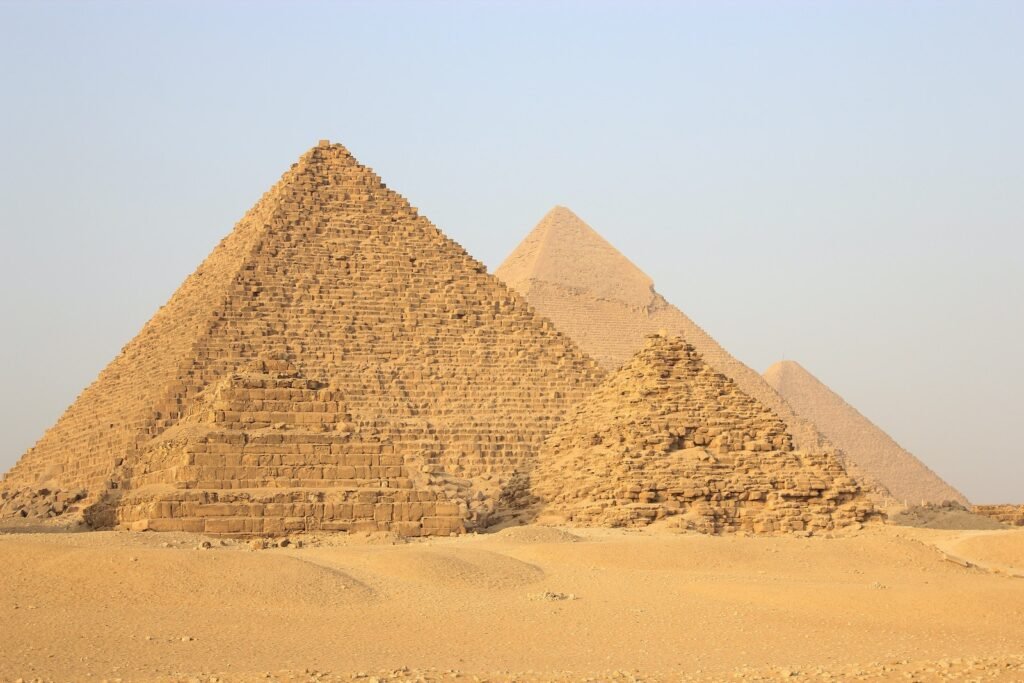Archaeology is a fascinating field that allows us to uncover the mysteries of our past. Throughout history, civilizations have risen and fallen, leaving behind remarkable structures and artifacts that serve as a testament to their existence. In this article, we will unveil the top 10 archaeological marvels from around the world, each offering a glimpse into the rich history of humanity. From the towering pyramids of Egypt to the majestic Taj Mahal in India, these sites are not only architectural wonders but also windows to our collective past.
1. Egypt’s Great Pyramids: Architectural Wonders of Antiquity
The Great Pyramids of Giza are an awe-inspiring sight that have stood the test of time for over 4,500 years. These monumental structures were built as tombs for the pharaohs of ancient Egypt, showcasing the architectural prowess and engineering marvels of the civilization. The largest pyramid, known as the Great Pyramid, is one of the Seven Wonders of the Ancient World and continues to intrigue researchers and visitors alike.
2. Greece’s Acropolis: Ancient Citadel of Athena’s Legacy
Perched atop a rocky hill in Athens, the Acropolis is a symbol of ancient Greece’s cultural and architectural achievements. Dominated by the Parthenon, a temple dedicated to the goddess Athena, this archaeological marvel is a testament to the grandeur and elegance of Classical Greek architecture. The Acropolis is not only a UNESCO World Heritage site but also a revered symbol of democracy and civilization.
3. Italy’s Pompeii: Preserved Enigma of Roman Civilization
The city of Pompeii, frozen in time by the eruption of Mount Vesuvius in 79 AD, offers a unique glimpse into the daily life of ancient Romans. The remarkably preserved ruins provide an unparalleled insight into the architecture, art, and social structure of the time. With its well-preserved frescoes, elaborate mosaics, and ancient streets, Pompeii continues to captivate visitors who seek to understand the daily routines of a bygone era.
4. China’s Terracotta Army: Buried Guardians of an Empire
Discovered in 1974, the Terracotta Army near Xi’an, China, is a striking archaeological find that showcases the military might of the first emperor of China, Qin Shi Huang. This vast collection of life-sized clay soldiers, horses, chariots, and weapons was created to protect the emperor in the afterlife. The intricacy and scale of this burial site make it one of the most remarkable archaeological discoveries in history.
5. Jordan’s Petra: The Rose City Carved in Red Stone
Hidden amidst the rugged mountains of Jordan, Petra is a breathtaking archaeological site known as the “Rose City” due to the color of its stone. Carved into the cliffs by the Nabateans around 300 BCE, this ancient city served as a trading hub and boasts impressive structures, including the iconic Treasury and the Monastery. The intricate rock-cut architecture and the rich history of Petra make it a must-visit destination for archaeology enthusiasts.
6. Mexico’s Chichen Itza: Maya Ruins Wrapped in Mystery
Chichen Itza, located in the Yucatan Peninsula of Mexico, is a remarkable archaeological site that was once a major center of the Maya civilization. The site features awe-inspiring structures such as the Pyramid of Kukulcan, the Temple of Warriors, and the Great Ball Court. The precise astronomical alignments and intricate architectural details of Chichen Itza continue to fascinate researchers, unraveling the mysteries of the Maya civilization.
7. Cambodia’s Angkor Wat: Temple Complex of the Khmer Empire
Angkor Wat, the largest religious monument in the world, is a true masterpiece of the ancient Khmer civilization. Built in the 12th century, this sprawling temple complex in Cambodia is dedicated to the Hindu god Vishnu. The intricate carvings, grandeur of the architecture, and vastness of the site have made Angkor Wat an iconic UNESCO World Heritage site and a symbol of Cambodia’s cultural heritage.
8. Peru’s Machu Picchu: Incan Citadel in the Andes Mountains
Nestled high in the Andes Mountains of Peru, Machu Picchu is an awe-inspiring Incan citadel and a testament to the engineering prowess of the ancient civilization. This “Lost City of the Incas” was built in the 15th century and remained hidden from the world until its rediscovery in 1911. The perfectly fitted stone walls, agricultural terraces, and intricate water channels of Machu Picchu continue to evoke a sense of wonder and admiration.
9. Turkey’s Ephesus: Ancient Roman City on the Aegean Coast
Ephesus, located on the Aegean coast of Turkey, was once a bustling ancient Roman city and one of the largest cities in the world. This archaeological marvel showcases the grandeur and sophistication of Roman urban planning and architecture. The Library of Celsus, the Great Theater, and the Temple of Artemis are just a few of the well-preserved structures that make Ephesus a must-visit destination for history enthusiasts.
10. India’s Taj Mahal: Mughal Masterpiece in Marble and Love
The Taj Mahal, located in Agra, India, is not only a stunning architectural marvel but also an enduring symbol of love. Built by Emperor Shah Jahan in the 17th century as a mausoleum for his beloved wife, Mumtaz Mahal, this UNESCO World Heritage site is an exquisite blend of Persian, Islamic, and Indian architectural styles. The intricate marble inlay work, symmetrical design, and serene surroundings make the Taj Mahal a true testament to human craftsmanship and devotion.
These top 10 archaeological marvels offer us a glimpse into the fascinating history of different civilizations and their remarkable achievements. Each site tells a unique story, shedding light on the lifestyles, beliefs, and achievements of our ancestors. Whether it is the towering pyramids of Egypt or the serene beauty of the Taj Mahal, these archaeological wonders continue to inspire awe and admiration, reminding us of the timeless beauty of human creativity and ingenuity. Exploring these sites not only allows us to unravel the mysteries of the past but also deepens our understanding and appreciation for the diverse cultures that have shaped our world.

